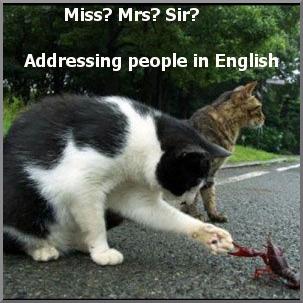How to Address People in English
Non-native speakers sometimes have trouble figuring out what to call people, and how formal to be. This guide will help you understand the differences, and help you feel more confident when talking to new people, whether they be friends, teachers or interviewers!
What to call someone is even difficult for native speakers! Sometimes it’s hard to decide whether to be formal and how much of someone’s status to recognize. Do you call your partner’s mom Miss or Mrs., or just Lucy? Should you call your boss Mr. Smith, or just Joe?
Here is a guide to help you understand how to address people in English.
When speaking with a man and using his name, you would refer to him as Mister [Mr.] + (Last Name).
Example:
George Clooney would be known as Mister Clooney. If you were to write to him, you would write Mr. Clooney.
You probably wouldn’t call him George unless you were already friends, or he was introduced to you as George.
Sir - Used when addressing a man without using his name.
Example:
“Excuse me, sir, you forgot your bag!”
When speaking with a woman, and using her name, you might call her Miss, Misses [Mrs.], or Mizz [Ms.] (Last Name)
This can be a bit confusing, as it is difficult to decide what to call someone. Many people feel strongly about the titles that are used, so if you are unsure, ask! It is better to ask and find out for sure than accidentally insult someone.
Miss + Last Name - Used to address an unmarried woman.
Example:
Miss Bosworth taught us how to use phrasal verbs.
Misses [Mrs.] + Last Name - Used to address a married woman who uses her husband’s last name.
Example:
“Hello Mrs. Martinez, it’s nice to meet you.”
Mizz [Ms.] + Last Name can be used for a married or unmarried woman. Often this is used in a business setting. This is the best option if you are unsure whether someone is married or unmarried.
Example:
“Ms. Kim starts tomorrow as our new manager.”
There are 3 options when addressing a woman without using her last name.
Miss - Used to address a young woman.
Example:
“Miss, your coffee is ready.”
Madam – Used to address an adult female.
Example:
I’m sorry madam, but we just sold the last blue scarf.
Ma’am (rhymes with “ham”) - Also used to address an adult female, but is used mainly in North America.
Example:
“Ma’am, would you like chocolate on your cappuccino?”
There are also two titles that have nothing to do with gender, but only with profession.
Doctor [Dr.] + (Last Name) – Used to address a doctor, male or female.
Example:
“Dr. Stern, can you tell me the best medication to take for this stubborn cough?“
Professor [Prof.] + (Last Name) – Used to address a university professor, male or female.
Example:
“Professor McGonagall, could you help me understand the focus of this chapter?”
Perfecting the use of these titles can help in many situations and will make you look professional and polite, helping you succeed! You can practice addressing people at an internship placement while taking English courses.

